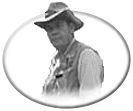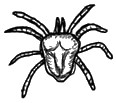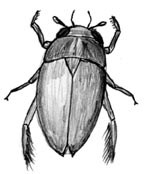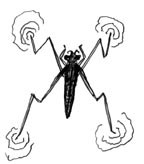 Other
Aquatic Critters Other
Aquatic Critters
Drawings
and article by Ron Newman
Many
of the so-called 'aquatics' are only found in ponds, swamps, marshes,
and pools rather than on the open waters of our trout lakes.
Black
flies, Crane Flies, Mosquitoes and so on, are aquatic, but not
of much importance to the fly fisher. Often these only become
a trout food when an adult accidentally falls into one of our
lakes or streams.
Others,
such as the snail or daphnia are a fairly regular food source
of the trout. All together, these miscellaneous aquatic critters
comprise about 8% of the feeding samples for trout in our lakes.
Although this is a significant portion of the feed, most are still
not important to the fly fisher.
Aquatic
Worms:
Leeches,
Horsehair Worms, and various aquatic earthworms are found in our
lakes. Leeches
(Annelida Hirudinea) are discussed in another section on this
site. However, it should be noted that leeches comprise slightly
more than 1% of a trout's seasonal diet.
Sometimes
other aquatic worms can be mistaken for leeches. Some aquatic
worms also possess suckers or mouths that look much like the leech.
If it has suckers on both the front and the back end, you can
be fairly certain it is a leech.
The
Horsehair Worm is an interesting looking critter. It is very
long (up to two feet in length) and very slim and looks much like
the hair from a horses tail or mane. It swims much like a snake
but is often found inter-twined with itself or other horsehair
worms in a ball. As a larva, they are an internal parasite of
various insects.
The
Horsehair Worm belongs to Nematoda and these do not have body
segments. Although the trout may feed on these, I have not yet
found one in a feeding sample.
The
aquatic earthworm also belongs to Annelida and is segmented
like a leech. There are more than 200 species of aquatic earthworm
in North America. Many species look like the terrestrial earthworm,
but many also have hairs or bristles on their tail for swimming.
Most feed on the bottom muck but some are predacious. I haven't
found these in trout feeding samples in our lakes but they would
digest very quickly and be hard to identify.
Clams
and Mussels:
Clams
and Mussels (mostly just called clams) belong to Mollusca and
can be found in some of our lakes and rivers. These are shelled
bi-valves. Because they burrow into the bottom substrates they
are not often obvious to the fly fisher. On some lakes in the
Prince George
area I have had clams (or mussels?) actually attach themselves
to my fly line or leader when retrieving along the lake bottom?
The line passes through the open shells, the clam closes because
of the disturbance and it becomes attached to the line.
On
the Thompson
River and other major river systems, clamshells can often
be found along the banks and shorelines. The ancient Indians harvested
clams. If you see shells buried in the bank, they are often indicative
of an archeological site.
These
mollusks are not restricted to Prince George or our rivers. I
have found these in feeding samples on some of our pristine, clear
water lakes. For example, I have found very small clams in feeding
samples from Knouff
Lake several times. The largest of these was not more than
a quarter inch in size but I was quite surprised to find them.
I have to admit that I didn't check these closely and it is possible
that they were actually "clam shrimp" (Conchostraca). I promise
to do a proper check on sample next time to be sure what they
are.
Crane
Fly:
The
Crane Fly is a Diptera (two-winged fly) and is a larger cousin
of our Chironomid.
These are also called Leather Jackets and I grew up calling them
Mosquito Hawks. They look like a very large mosquito. The larva
and pupa are usually found in marshes or along the shoreline rather
than the deeper water of the lake. Adults are only near the water
for laying eggs. However, if an adult were to fall in the water,
I'm fairly sure a waiting trout would snap it up.
Hellgrammites:
 Many
Caddis, and the larva of other species, are often incorrectly
called Hellgrammites. The true Hellgrammites belong to the order
Megaloptera, which contain the fishflies, dobsonflies and alderflies.
Most of these are called hellgrammites by the fly fisher. They
generally tend to live in running water but at least one species
is found in our lakes. Many
Caddis, and the larva of other species, are often incorrectly
called Hellgrammites. The true Hellgrammites belong to the order
Megaloptera, which contain the fishflies, dobsonflies and alderflies.
Most of these are called hellgrammites by the fly fisher. They
generally tend to live in running water but at least one species
is found in our lakes.
The
adult looks much like a Stonefly.
The larva of the species I have seen in our lakes has a wicked
pair of pincers on its head for snaring prey. I wouldn't pick
it up and can understand why the fish don't feed on it. I have
heard that some of the stream species are not quite so veracious
and are actually considered a food source for the trout. Can't
prove it by me. However, from the species I saw in our lakes I
know why the 'hell' is in their name.
Mosquito:
 The
mosquito is a Diptera and closely related to the Chironomid.
I often hear fly fishers say they are using a 'mosquito' pattern
when flyfishing. If the fly is proving successful, it isn't because
the fish are taking it as a mosquito. It is more likely being
taken as a Chironomid. The mosquito (Culicidae) is not a common
food source for the trout. The
mosquito is a Diptera and closely related to the Chironomid.
I often hear fly fishers say they are using a 'mosquito' pattern
when flyfishing. If the fly is proving successful, it isn't because
the fish are taking it as a mosquito. It is more likely being
taken as a Chironomid. The mosquito (Culicidae) is not a common
food source for the trout.
The
mosquito must obtain its oxygen directly from the atmosphere.
It does this through a siphon tube that it extends through the
surface tension of the water. It then draws in air through the
tube. If wave action occurs, it will likely break this surface
contact and drown the mosquito. Because of this, these insects
are restricted to marshes, ponds, swamps, puddles and pools that
don't have wave action. They are not normally found on our interior
fishing lakes.
Semi-Microscopic
Organisms:
There
are quite a number of organisms in the lakes that are almost microscopic
in size. Although very small, these are often consumed by the
trout and appear like mush or tapioca in a feeding sample. The
total group was found in 4% of the feeding samples examined. I
don't usually distinguish one type of 'mush' from another but
will provide some of the more common types of semi-microscopic
organisms for those interested.
- Copepods
- These small critters are related to shrimp and look like a
comma ( , ) in the water. They are sometimes referred to as
fish lice but only one genus is actually parasitic on fish.
Most are free swimming and are fed on by trout, particularly
the smaller fish. They can occur in great numbers at certain
times of the year.
 Daphnia
- these are also called "water fleas". These look like a
small dot in the water with antennae. They are closely related
to the Copepods and Shrimp
and are found in most freshwater environments. The trout feed
on daphnia more frequently than Copepods and I have even found
these in the feeding samples of larger trout. They tend to migrate
upward in the water column in the evening or after dark and
downward in the daylight. Daphnia
- these are also called "water fleas". These look like a
small dot in the water with antennae. They are closely related
to the Copepods and Shrimp
and are found in most freshwater environments. The trout feed
on daphnia more frequently than Copepods and I have even found
these in the feeding samples of larger trout. They tend to migrate
upward in the water column in the evening or after dark and
downward in the daylight.- Fish
Lice - These are related to Copepods but are generally a
little bit larger. They have four pair of swimming legs and
attach themselves to the gills of a fish and feed on their host's
blood. It takes a very close examination to see these on the
gills of a fish. Fish that are 'jumping' rather than 'rising'
are often said to be shaking these lice from their gills.
 Water
Mites - These are related to spiders. However, the larva
only has six legs and it is not until they reach the adult stage
that they have eight legs. The fly fisher is most likely to
observe the red water mites on our interior lakes. They look
like a small red dot with legs in the adult free-living stage.
The larva is parasitic on insects or other aquatics (caddis,
dragonflies,
boatmen,
snails, mussels, shrimp,
etc). The mites don't tend to congregate in large numbers and
so are seldom found in feeding samples. Water
Mites - These are related to spiders. However, the larva
only has six legs and it is not until they reach the adult stage
that they have eight legs. The fly fisher is most likely to
observe the red water mites on our interior lakes. They look
like a small red dot with legs in the adult free-living stage.
The larva is parasitic on insects or other aquatics (caddis,
dragonflies,
boatmen,
snails, mussels, shrimp,
etc). The mites don't tend to congregate in large numbers and
so are seldom found in feeding samples.
Snails
and Limpets:
Like
clams and mussels, snails and limpets belong to Mollusca. However,
they are uni-valve, rather than bi-valve. The single shell of
the Limpet usually spirals in a cone shape while the true snail
usually has the shell spiral outward from a central point (do-nut
shaped without the inside hole). Both are generally called snails.
The shells are made of calcium carbonate and so these are found
in more abundance on the lower elevation and alkaline lakes, rather
than the higher elevation and acidic lakes.
Trout
will feed on snails and limpets throughout the open water season.
They comprise almost two percent (2%) of the feeding samples,
which is significant, but because their movement is "slow as a
snail" they are not a food source that the fly fisher will often
imitate. Besides, those fish feeding on snails often get the muddy
taste associated with algae.
Water
Beetles:
 The
aquatic or Water Beetles are a part of the order Coleoptera
just like their terrestrial relatives. There are over 1,000 types
of beetles that spend a part of their life in the water. The
aquatic or Water Beetles are a part of the order Coleoptera
just like their terrestrial relatives. There are over 1,000 types
of beetles that spend a part of their life in the water.
Most
of the water beetles prefer ponds, swamps or the marshy area of
lakes as opposed to the open waters of a lake.
The
pupa of most water beetles are hatched along the moist shoreline
rather than in the water and most adults rely on atmospheric oxygen
for breathing.
The
Dytiscus beetle is a predaceous diving beetle that may sometimes
be encountered and has a very large set of biting jaws. The Whirligig
Beetles are sometimes seen in a group on the water surface. These
swim erratically, often in small circles, and will dive when disturbed.
The
small scavenger beetles are the ones you will most likely see
when launching your boat. These are usually small, black, have
the typical oval shape of a beetle and usually dive into the bottom
muck when disturbed.
Most
of the water beetles are not of much importance to the fly fisher.
Only on a few rare occasions have I found any water beetles in
the feeding samples and these were the small scavenger beetles.
I suspect they were accidentally ingested as the fish was feeding
on something else.
Water
Bugs:
The
order Hemiptera is the Water Bugs and includes the Waterboatman
(see section
on this site). Most of the water bugs are highly predacious.
Most can deliver a good bite or sting and for that reason the
trout tend to avoid them. The trout often consumes the few species,
like the Waterboatman, that don't bite or sting. Quite a number
of the water bugs almost look like water beetles at first glance.
Some of the more common water bugs are described below. 
- Backswimmer
- If you have ever been stung by one of these in your swimming
pool, then you will understand why the trout stay away from
these. The life cycle and appearance is much like the boatman
except it often swims or paddles through the water 'up-side-down'
and are usually larger than a boatman. Only once have I found
these in a feeding sample and I'm sure that was a mistake.
- The
Giant Water Bug - These can get over two inches in size,
are highly predacious and very vicious. They will bite the toes
of someone swimming and have even been known to attack newly
hatched ducklings. If you have ever seen a large beetle-like
bug carrying more than 100 eggs attached to its back, then you
will know what the Giant Water Bug looks like.
 The
Water Strider - or Water Skaters, or as I call them,
the Water Skipper. These are the guys with the very long legs
that sit on the water surface and skip along in short bursts.
They only appear to have four legs but actually have six. They
seem to frequent the high elevation acidic lakes more than the
lower elevation alkaline lakes. They are predacious but I don't
know of anyone who was ever stung or bitten by one. Even so,
the trout tend to avoid them unless food is scarce. Maybe they
just taste bad?? The
Water Strider - or Water Skaters, or as I call them,
the Water Skipper. These are the guys with the very long legs
that sit on the water surface and skip along in short bursts.
They only appear to have four legs but actually have six. They
seem to frequent the high elevation acidic lakes more than the
lower elevation alkaline lakes. They are predacious but I don't
know of anyone who was ever stung or bitten by one. Even so,
the trout tend to avoid them unless food is scarce. Maybe they
just taste bad??
Be
sure to read other articles by Ron
Newman
Study
Other Insects
| Tip &
Techniques |
Study Fly Patterns
|



 Other
Aquatic Critters
Other
Aquatic Critters  Many
Caddis, and the larva of other species, are often incorrectly
called Hellgrammites. The true Hellgrammites belong to the order
Megaloptera, which contain the fishflies, dobsonflies and alderflies.
Most of these are called hellgrammites by the fly fisher. They
generally tend to live in running water but at least one species
is found in our lakes.
Many
Caddis, and the larva of other species, are often incorrectly
called Hellgrammites. The true Hellgrammites belong to the order
Megaloptera, which contain the fishflies, dobsonflies and alderflies.
Most of these are called hellgrammites by the fly fisher. They
generally tend to live in running water but at least one species
is found in our lakes.  The
mosquito is a Diptera and closely related to the
The
mosquito is a Diptera and closely related to the  Daphnia
- these are also called "water fleas". These look like a
small dot in the water with antennae. They are closely related
to the Copepods and
Daphnia
- these are also called "water fleas". These look like a
small dot in the water with antennae. They are closely related
to the Copepods and  Water
Mites - These are related to spiders. However, the larva
only has six legs and it is not until they reach the adult stage
that they have eight legs. The fly fisher is most likely to
observe the red water mites on our interior lakes. They look
like a small red dot with legs in the adult free-living stage.
The larva is parasitic on insects or other aquatics (
Water
Mites - These are related to spiders. However, the larva
only has six legs and it is not until they reach the adult stage
that they have eight legs. The fly fisher is most likely to
observe the red water mites on our interior lakes. They look
like a small red dot with legs in the adult free-living stage.
The larva is parasitic on insects or other aquatics ( The
aquatic or Water Beetles are a part of the order Coleoptera
just like their terrestrial relatives. There are over 1,000 types
of beetles that spend a part of their life in the water.
The
aquatic or Water Beetles are a part of the order Coleoptera
just like their terrestrial relatives. There are over 1,000 types
of beetles that spend a part of their life in the water. 
 The
Water Strider - or Water Skaters, or as I call them,
the Water Skipper. These are the guys with the very long legs
that sit on the water surface and skip along in short bursts.
They only appear to have four legs but actually have six. They
seem to frequent the high elevation acidic lakes more than the
lower elevation alkaline lakes. They are predacious but I don't
know of anyone who was ever stung or bitten by one. Even so,
the trout tend to avoid them unless food is scarce. Maybe they
just taste bad??
The
Water Strider - or Water Skaters, or as I call them,
the Water Skipper. These are the guys with the very long legs
that sit on the water surface and skip along in short bursts.
They only appear to have four legs but actually have six. They
seem to frequent the high elevation acidic lakes more than the
lower elevation alkaline lakes. They are predacious but I don't
know of anyone who was ever stung or bitten by one. Even so,
the trout tend to avoid them unless food is scarce. Maybe they
just taste bad??